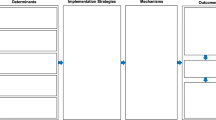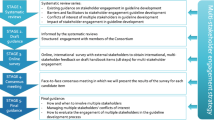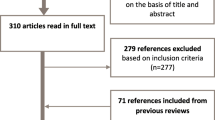Abstract
In countries such as Australia, the UK and Canada, decisions on whether to fund new health technologies are commonly informed by decision analytic models. While the impact of making inappropriate structural choices/assumptions on model predictions is well noted, there is a lack of clarity about the definition of key structural aspects, the process of developing model structure (including the development of conceptual models) and uncertainty associated with the structuring process (structural uncertainty) in guidelines developed by national funding bodies. This forms the focus of this article. Building on the reports of good modelling practice, and recognising the fundamental role of model structuring within the model development process, we specified key structural choices and provided ideas about model structuring for the future direction. This will help to further standardise guidelines developed by national funding bodies, with potential impact on transparency, comprehensiveness and consistency of model structuring. We argue that the process of model structuring and structural sensitivity analysis should be documented in a more systematic and transparent way in submissions to national funding bodies. Within the decision-making process, the development of conceptual models and presentation of all key structural choices would mean that national funding bodies could be more confident of maximising value for money when making public funding decisions.
Similar content being viewed by others
References
Buxton MJ, Drummond MF, Van Hout BA, Prince RL, Sheldon TA, Szucs T, et al. Modelling in economic evaluation: an unavoidable fact of life. Health Econ. 1997;6:217–27.
Caro JJ, Briggs AH, Siebert U, et al. Modeling good research practices–overview: a report of the ISPOR-SMDM modeling good research practices task force-1. Med Decis Making. 2012;32:667–77.
Cooper NJ, Sutton AJ, Ades AE, Paisley S, Jones DR, Economic WGUE. Use of evidence in economic decision models: practical issues and methodological challenges. Health Econ. 2007;16:1277–86.
Drummond MF, Sculpher MJ, Claxton K, et al. Methods for the economic evaluation of health care programmes. 4th ed. Oxford: Oxford University Press; 2015.
Haji Ali Afzali H, Karnon J. Exploring structural uncertainty in model-based economic evaluations. Pharmacoeconomics. 2015;33:435–43.
Tappenden P. Conceptual modelling for health economic model development. HEDS Discussion Paper 12/05. 2012. http://eprints.whiterose.ac.uk/74464/1/HEDSDP1205.pdf. Accessed 1 Dec 2015.
Ghabri S, Cleemput I, Josselin JM. Towards a new framework for addressing structural uncertainty in health technology assessment guidelines. Pharmacoeconomics. 2018;36:127–30.
Andronis L, Barton P, Bryan S. Sensitivity analysis in economic evaluation: an audit of NICE current practice and a review of its use and value in decision-making. Health Technol Assess. 2009;13:iii, ix–xi, 1–61.
Cooper NJ, Coyle D, Abrams KR, et al. Use of evidence in decision models: an appraisal of health technology assessments in the UK to date. J Health Serv Res Pol. 2005;10:245–50.
Draper D. Assessment and propagation of model uncertainty. J R Stat Soc Series B Stat Methodol. 1995;57:45–97.
Strong M, Oakley JE. When is a model good enough? Deriving the expected value of model improvement via specifying internal model discrepancies. Siam-Asa J Uncertain. 2014;2:106–25.
Bojke L, Claxton K, Sculpher M, et al. Characterizing structural uncertainty in decision analytic models: a review and application of methods. Value Health. 2009;12:739–49.
Brisson M, Edmunds WJ. Impact of model, methodological, and parameter uncertainty in the economic analysis of vaccination programs. Med Decis Making. 2006;26:434–46.
Frederix GWJ, van Hasselt JGC, Schellens JHM, Hovels A, Raaijmakers JAM, Huitema ADR, et al. The impact of structural uncertainty on cost-effectiveness models for adjuvant endocrine breast cancer treatments: the need for disease-specific model standardization and improved guidance. Pharmacoeconomics. 2014;32:47–61.
Jackson CH, Bojke L, Thompson SG, Claxton K, Sharples LD. A framework for addressing structural uncertainty in decision models. Med Decis Making. 2011;31:662–74.
Brennan A, Chick SE, Davies R. A taxonomy of model structures for economic evaluation of health technologies. Health Econ. 2006;15:1295–310.
Squires H, Chilcott J, Akehurst R, Burr J, Kelly MP. A systematic literature review of the key challenges for developing the structure of public health economic models. Int J Public Health. 2016;61:289–98.
Le QA. Structural uncertainty of Markov models for advanced breast cancer: a simulation study of lapatinib. Med Decis Making. 2016;36:629–40.
Roberts M, Russell LB, Paltiel AD, et al. Conceptualizing a model: a report of the ISPOR-SMDM modeling good research practices task force-2. Med Decis Making. 2012;32:678–89.
Kaltenthaler E, Tappenden P, Paisley S, Squires H. Identifying and reviewing evidence to inform the conceptualisation and population of cost-effectiveness models. NICE DSU Technical Support Document 13. Sheffield: School of Health and Related Research, University of Sheffield; 2011 [December 2015]. http://www.nicedsu.org.uk. Accessed 9 May 2018.
Claxton K, Palmer S, Longworth L, Bojke L, Griffin S, McKenna C, et al. Informing a decision framework for when NICE should recommend the use of health technologies only in the context of an appropriately designed programme of evidence development. Health Technol Assess. 2012;16:1–323.
Briggs AH, Weinstein MC, Fenwick EA, Karnon J, Sculpher MJ, Paltiel AD, et al. Model parameter estimation and uncertainty: a report of the ISPOR-SMDM Modeling Good Research Practices Task Force–6. Value Health. 2012;15:835–42.
Weinstein MC, O’Brien B, Hornberger J, Jackson J, Johannesson M, McCabe C, et al. Principles of good practice for decision analytic modeling in health-care evaluation: report of the ISPOR task force on good research practices-modeling studies. Value Health. 2003;6:9–17.
Briggs AH, Claxton K, Sculpher MJ. Decision modelling for health economic evaluation. Oxford: Oxford University Press; 2006.
Gray AM, Clarke PM, Wolstenholme JL, et al. Applied methods of cost effectiveness analysis in health care. New York: Oxford University Press; 2011.
Gold MR. Cost-effectiveness in health and medicine. New York: Oxford University Press; 1996.
Bilcke J, Beutels P, Brisson M, Jit M. Accounting for methodological, structural, and parameter uncertainty in decision-analytic models: a practical guide. Med Decis Making. 2011;31:675–92.
Kaltenthaler E, Tappenden P, Paisley S, Squires H. NICE DSU Technical Support Document 13: identifying and reviewing evidence to inform the conceptualisation and population of cost-effectiveness models. NICE Decision Support Unit Technical Support Documents. London: NICE; 2011.
Haji Ali Afzali H, Karnon J, Merlin T. Improving the accuracy and comparability of model-based economic evaluations of health technologies for reimbursement decisions: A methodological framework for the development of reference models. Med Decis Making. 2013;33:333–42.
Sullivan PW, Valuck R, Saseen J, MacFall HM. A comparison of the direct costs and cost effectiveness of serotonin reuptake inhibitors and associated adverse drug reactions. CNS Drugs. 2004;18:911–32.
Haji Ali Afzali H, Karnon J, Gray J. A critical review of model-based economic studies of depression modelling techniques, model structure and data sources. Pharmacoeconomics. 2012;30:461–82.
Schulman KA, Lynn LA, Glick HA, Eisenberg JM. Cost effectiveness of low-dose zidovudine therapy for asymptomatic patients with human immunodeficiency virus (HIV) infection. Ann Intern Med. 1991;114:798–802.
Hlatky MA, Owens DK, Sanders GD. Cost-effectiveness as an outcome in randomized clinical trials. Clin Trials. 2006;3:543–51.
Haji Ali Afzali H, Karnon J, Gray J. A proposed model for economic evaluations of major depressive disorder. Eur J Health Econ. 2012;13:501–10.
Price MJ, Welton NJ, Briggs AH, Ades AE. Model averaging in the presence of structural uncertainty about treatment effects: influence on treatment decision and expected value of information. Value Health. 2011;14:205–18.
O’Mahony JF, Newall AT, van Rosmalen J. Dealing with time in health economic evaluation: methodological issues and recommendations for practice. Pharmacoeconomics. 2015;33:1255–68.
Wooldridge JM. Econometric analysis of cross section and panel data. 2nd ed. Cambridge (MA): MIT Press; 2010.
Connock M, Hyde C, Moore D. Cautions regarding the fitting and interpretation of survival curves examples from NICE single technology appraisals of drugs for cancer. Pharmacoeconomics. 2011;29:827–37.
Ara R, Brazier JE. Populating an economic model with health state utility values: moving toward better practice. Value Health. 2010;13:509–18.
Buckinx F, Reginster JY, Petermans J, Croisier JL, Beaudart C, Brunois T, et al. Relationship between frailty, physical performance and quality of life among nursing home residents: the SENIOR cohort. Aging Clin Exp Res. 2016;28:1149–57.
Ara R, Wailoo A. Using health state utility values in models exploring the cost-effectiveness of health technologies. Value Health. 2012;15:971–4.
Ara R, Wailoo A. Estimating health state utility values for joint health conditions: a conceptual review and critique of the current evidence. Med Decis Making. 2013;33:139–53.
Basu A, Manca A. Regression estimators for generic health-related quality of life and quality-adjusted life years. Med Decis Making. 2012;32:56–69.
Barton P, Bryan S, Robinson S. Modelling in the economic evaluation of health care: selecting the appropriate approach. J Health Serv Res Policy. 2004;9:110–8.
Pennington B, Filby A, Owen L, Taylor M. Smoking cessation: a comparison of two model structures. Pharmacoeconomics. 2018. https://doi.org/10.1007/s40273-018-0657-y (Epub 2018 May 8).
Bojke L, Claxton K, Bravo-Vergel Y, Sculpher M, Palmer S, Abrams K. Eliciting distributions to populate decision analytic models. Value Health. 2010;13:557–64.
National Institute for Health and Care Excellence (NICE). Single technology appraisal: user guide for company evidence submission template. UK; 2015. https://www.nice.org.uk/process/pmg24/chapter/cost-effectiveness. Accessed 10 Apr 2018.
CADTH. Guidelines for the economic evaluation of health technologies: Canada 2017. https://www.cadth.ca/dv/guidelines-economic-evaluation-health-technologies-canada-4th-edition. Accessed 10 Apr 2018.
Pharmaceutical Benefits Advisory Committee (PBAC). Guidelines for preparing a submission to the Pharmaceutical Benefits Advisory Committee 2016. https://pbac.pbs.gov.au/information/printable-version-of-guidelines.html. Accessed 10 Apr 2018.
Haute Autorité de Santé (HAS). Choices in methods for economic evaluation. Saint-Denis La Plaine: Department of Economics and Public Health Assessment (HAS); 2012.
Latimer N. Survival analysis for economic evaluations alongside clinical trials—extrapolation with patient-level data. NICE DSU Technical Support Document 14. Sheffield: School of Health and Related Research, University of Sheffield; 2013 [December 2015]. http://www.nicedsu.org.uk. Accessed 9 May 2018.
Husbands S, Jowett S, Barton P, Coast J. How qualitative methods can be used to inform model development. Pharmacoeconomics. 2017;35:607–12.
Haji Ali Afzali H, Gray J, Karnon J. Model performance evaluation (validation and calibration) in model-based studies of therapeutic interventions for cardiovascular diseases: a review and suggested reporting framework. Appl Health Econ Health Policy. 2013;11:85–93.
Tappenden P, Chilcott JB. Avoiding and identifying errors and other threats to the credibility of health economic models. Pharmacoeconomics. 2014;32:967–79.
Author information
Authors and Affiliations
Corresponding author
Ethics declarations
Author Contributions
HHAA conceptualised and drafted the manuscript, and all co-authors reviewed and suggested changes. All authors reviewed and approved the final draft.
Funding
The Alan Williams Fellowship Award (Centre for Health Economics, the University of York) received by Hossein Haji Ali Afzali contributed to the conceptualisation of this article. This study was also supported by the National Health and Medical Research Council (NHMRC) of Australia via funding provided for the Centre of Research Excellence in Frailty and Healthy Ageing.
Conflict of Interest
Hossein Haji Ali Afzali is a member of the Evaluation Sub-Committee of the Medical Services Advisory Committee and Jonathan Karnon is a member of the Economic Sub-Committee of the Pharmaceutical Benefits Advisory Committee. Laura Bojke has no conflicts of interest to declare.
Rights and permissions
About this article
Cite this article
Haji Ali Afzali, H., Bojke, L. & Karnon, J. Model Structuring for Economic Evaluations of New Health Technologies. PharmacoEconomics 36, 1309–1319 (2018). https://doi.org/10.1007/s40273-018-0693-7
Published:
Issue Date:
DOI: https://doi.org/10.1007/s40273-018-0693-7




